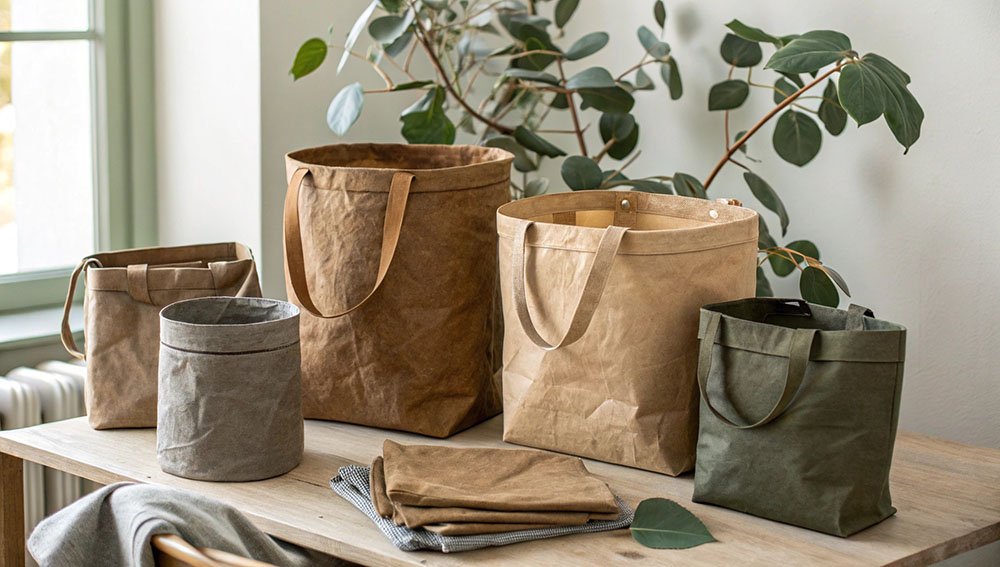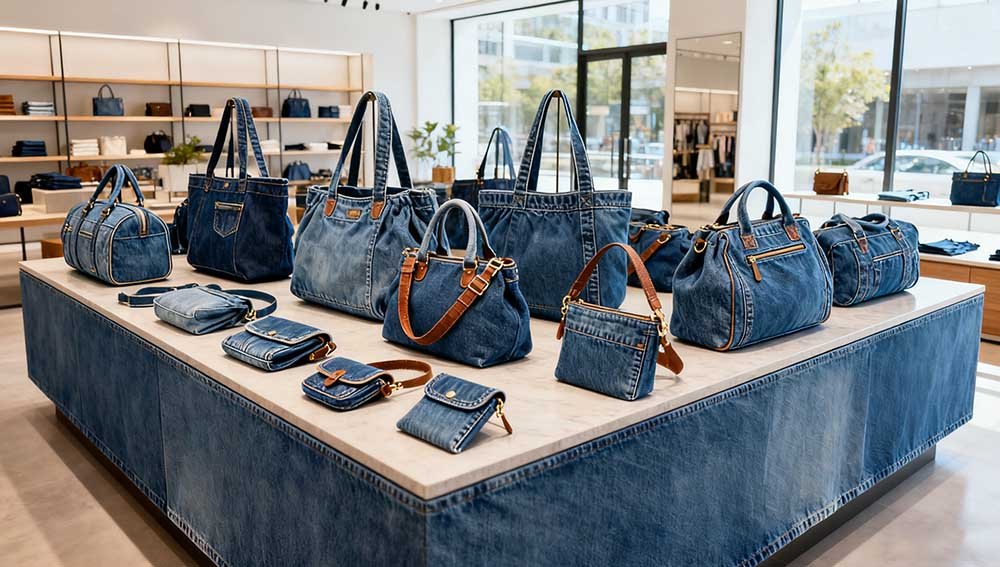Thinking about a neoprene bag for your brand or daily use? This material is popular, but is it the right choice? Know the good and the bad before you spend.
Neoprene bags offer great water resistance, good protection, and a modern style. But, they can be heavier, not very breathable, and cost more than basic fabric bags. Consider your specific needs—like beach trips or carrying electronics—to see if the benefits outweigh these few downsides.
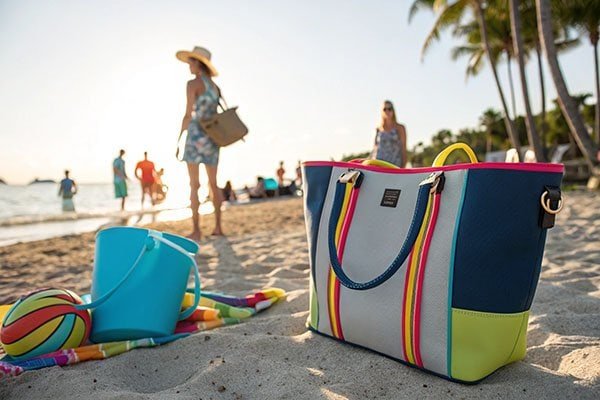
When looking at new materials, it is easy to get caught up in the hype. We need to look closely at what neoprene really offers so you can make a smart choice.
What Makes Neoprene Bags Stand Out in Design and Performance?
Need a bag that can handle spills and look sharp? Neoprene is a top choice for brands looking to combine function with a high-end feel.
Neoprene stands out because it is naturally water-resistant and scratch-proof. It offers good elasticity and insulation, giving a soft yet strong structure. This material is great for protecting contents and allows for many stylish designs.
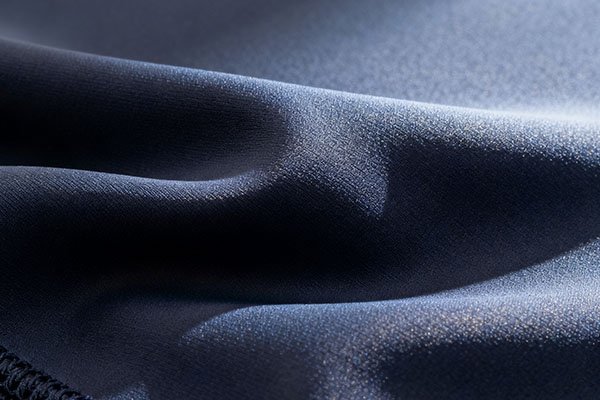
Neoprene offers several strong advantages over common materials like cotton or polyester. These unique properties make it very practical for a wide range of uses, appealing to both brand owners and final users.
First, its excellent water resistance is a major selling point. The material naturally repels water, keeping items dry and safe. This makes the bags perfect for travel, outdoor use, rainy commutes, or time spent at the beach.
Second, the material is highly durable. It is resistant to tears, abrasions, and general wear and tear, meaning the bags maintain a modern and premium look over time. This long lifespan supports a brand’s focus on quality.
Third, the natural elasticity of neoprene acts like a cushion. This flexibility allows the bag to safely hold varying loads without losing its shape. The light padding is excellent for protecting delicate items inside, such as electronics, cameras, or sunglasses, without the bulk of traditional padding.
Fourth, the structure of neoprene is soft yet supportive. This characteristic allows designers to create many shapes, giving it a much higher level of moldability than simple woven fabrics. The material supports many styles, from structured tote bags to comfortable backpacks.
Finally, neoprene also provides good insulation. This means it can help keep the temperature of contents slightly more stable, which is a great bonus for items like lunch or drink bottles. Overall, neoprene delivers high function, a long-lasting nature, and a premium, modern aesthetic that adds value.
| Fonctionnalité | Neoprene Bag | Common Fabric (e.g., Canvas) | Advantage for Business |
|---|---|---|---|
| Résistance à l'eau | Excellent (Naturally resistant) | Low (Needs coating) | Protects product, shows quality |
| Protection/Padding | High (Built-in cushion) | Low (No cushion) | Good for electronics, fragile items |
| Durabilité | High (Resistant to scratches) | Moderate (Prone to wear) | Longer product life, better brand image |
| Esthétique | Modern, Sleek, Premium Feel | Casual, Traditional | Supports higher pricing, brand value |
| Shape/Structure | Flexible, holds shape well | Soft, often collapses | Versatile design options |
What Are the Downsides of Neoprene Bags?
Neoprene seems perfect, but it has a few drawbacks. Do not let the good features make you ignore the material’s limits.
The main disadvantages of neoprene bags are their slightly heavier weight and poor breathability. Since it is a synthetic material, its environmental impact is often questioned, even though its great durability helps offset this. It is also more expensive than basic cloth.
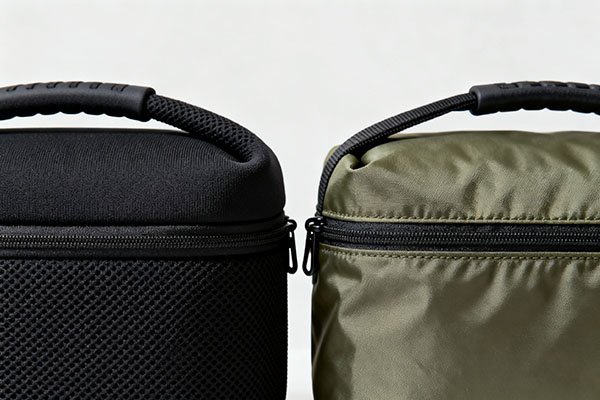
While neoprene is strong and functional, certain limitations must be understood before making a purchase decision. These disadvantages relate to comfort, cost, and material nature.
First, the material is slightly thicker and denser than common light fabrics, such as thin nylon. This thickness adds a little bulk and weight to the bag. For users looking for the most lightweight and foldable option, this can be a drawback, as it makes the bag less simple to pack down flat or carry for long, tiring periods.
Second, neoprene has very poor breathability1. It is a closed-cell structure, meaning it traps heat and moisture inside the bag. This low airflow means the bag is not the best choice for storing wet items, like sweaty gym clothes, for an extended period. If not cleaned regularly, it can also hold onto odors over time.
Third, neoprene is a synthetic polymer, originally derived from petrochemicals. This fact often raises questions about its sustainability among eco-conscious consumers. However, its outstanding durability and long life actually make it very valuable. By being reusable and long-lasting, a neoprene bag is a far better environmental choice than bags that wear out quickly and need frequent replacement. Brands should focus on this "durability equals sustainability" message.
Finally, the cost to make neoprene bags is higher than for simple cotton or basic polyester bags. This makes it better suited for brands targeting a mid-to-high-end position. Businesses must see this higher cost as an investment in a product that offers superior protection, function, and a high-quality look.
| Limitation | Impact on Use | Business Strategy | Mitigation |
|---|---|---|---|
| Thickness/Weight | Can feel bulky when fully packed; slightly heavier. | Best for products where protection is key (e.g., laptops). | Use thinner neoprene for simple designs; emphasize durability. |
| Low Breathability | Not ideal for damp clothes or very warm items; may retain odor. | Avoid for specific items; add external mesh pockets if needed. | Advise customers on proper use and care (regular cleaning). |
| Higher Cost | Not suitable for the lowest-priced segment. | Target mid-to-high-end customers who value quality. | Focus on premium look and long-term value in marketing. |
| Environmental View | Requires clear communication about material sourcing. | Highlight reusability, long life, and durability. | Look for newer, more eco-friendly neoprene alternatives. |
How to Choose the Right Neoprene Bag for Lifestyle?
Ready to choose a bag? The best neoprene bag for you depends fully on what you will use it for. Match the bag style to your daily activities.
Choose your neoprene bag based on your planned use: Tote bags are great for daily commute and light shopping. Backpacks are best for travel, fitness, and outdoor activities. Lunch bags keep food insulated. Beach bags hold up well against sand and water.
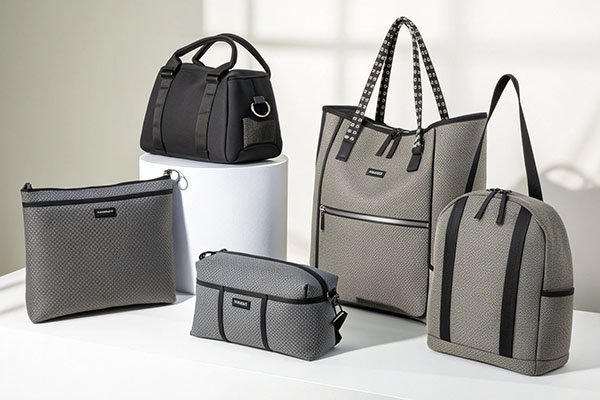
Neoprene’s versatility allows it to take many forms, making it suitable for almost any lifestyle need. We will look at four popular styles to help you choose the best fit for your needs.
Neoprene Tote Bag: The Commuter’s Choice
The Neoprene Tote Bag is ideal for the daily commute or shopping. Light padding protects laptops, tablets, or documents from scratches and minor bumps.
Neoprene’s sleek look suits office use and is water-resistant. Common thickness: 3 mm–5 mm to help the bag keep its shape.
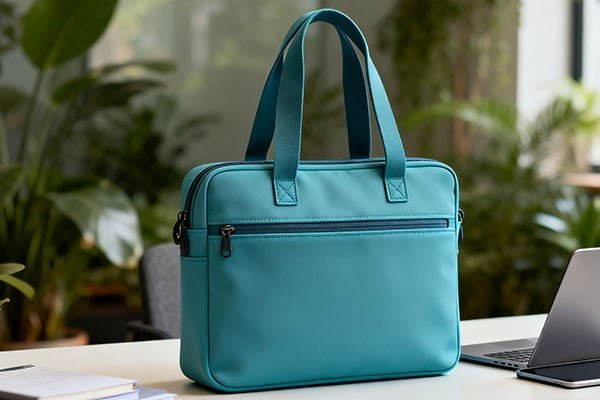
Neoprene Backpack: For Adventure and Fitness
Water-resistant and scratch-proof—great for gym, hiking, or weekend travel. Handles damp floors and light weather well.
Custom options: reinforced seams, padded shoulder straps, exterior mesh pockets.
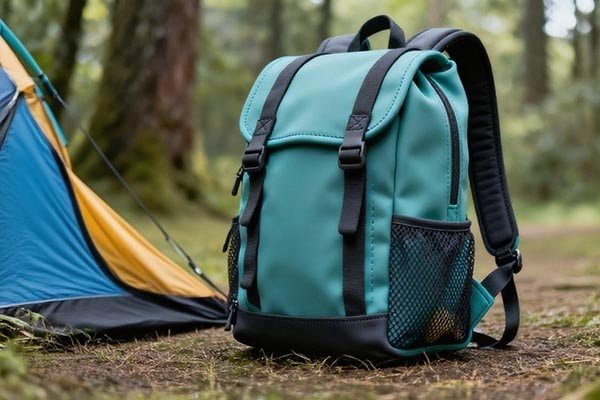
Neoprene Lunch Bag: Keeping Meals Right
Uses neoprene’s insulating properties to keep food warm or drinks cool for hours—better than simple paper bags.
Customizations: compact size, thermal lining, easy-clean strong zipper.
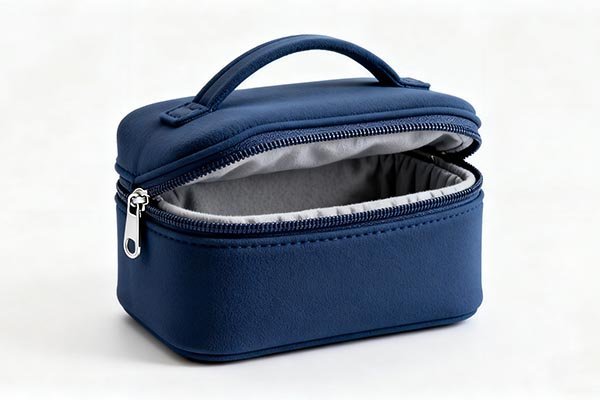
Neoprene Beach Bag: Sand and Water Friendly
Designed for the beach—neoprene repels water and won’t absorb sand, so cleanup is simple. Large enough for towels and sunscreen.
Customizations: rope handles, wide opening, reinforced durable base.
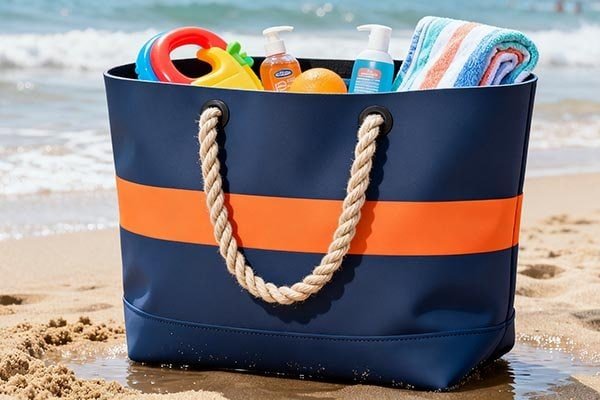
How to Care for and Maintain Neoprene Bag?
Proper care is key to making your neoprene bag last for years. Avoid common cleaning mistakes that can quickly damage the material.
For the best maintenance, hand wash your neoprene bag with a mild, gentle detergent in cool or lukewarm water. Squeeze out excess water gently. Always let it air dry in a well-ventilated space, away from direct, harsh sunlight, to prevent the material from hardening or fading.
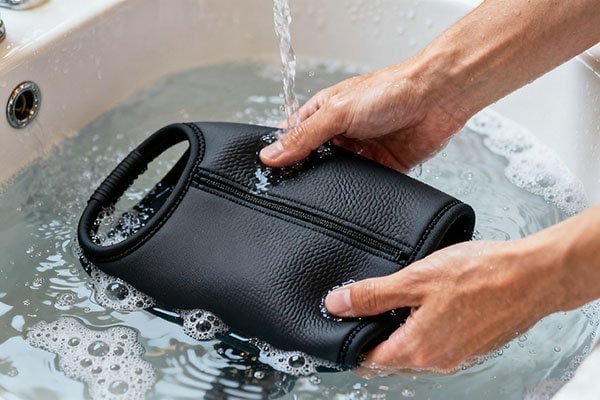
Taking care of a neoprene bag is easy, but specific maintenance steps are necessary to ensure its longevity and to protect its functional properties. Simple habits can greatly extend the life of your investment.
First, hand washing is the safest and most effective cleaning method. You must use a mild or neutral detergent, such as baby shampoo or a gentle laundry liquid, and use cool or lukewarm water. Avoid harsh chemicals, bleach, or solvent-based cleaners, as these can easily damage the synthetic material’s integrity and color.
Second, be very careful when removing water. After washing, gently press or squeeze out the excess water. Do not twist, wring, or aggressively pull the bag. Forceful wringing or the high spin speed of a washing machine can strain the material and the seams, which causes stretching or premature failure, reducing the bag’s useful life. Even for thin neoprene items, the stress is too high.
Third, the drying process is perhaps the most important step. Neoprene has a certain amount of heat tolerance, but long-term, direct exposure to strong sunlight, especially during the summer, must be avoided. UV rays from the sun can cause the synthetic rubber material to break down over time. This process is called degradation, which makes the material harden, lose its stretch, and fade in color. Therefore, you should always hang the bag to air dry in a well-ventilated, shady area. Keeping the bag flat or properly hung while drying also prevents permanent creases or wrinkles from forming. Following these care instructions will help the bag retain its shape, elasticity, and color for a very long time.
Conclusion
Neoprene bags are great for protection and style, but they are expensive and not very breathable. If you care for them well, their durability makes them worth the money.
Frequenty Asked Questions
Q: Are neoprene bags suitable for carrying very heavy items like textbooks or large grocery loads?
A: Neoprene offers strong support, but its primary advantage is protection and flexibility. For extremely heavy, non-cushioned loads, a reinforced canvas or heavy-duty nylon bag with a rigid base might be more structurally appropriate.
Q: Can neoprene bags be used as insulated coolers for frozen food or cold drinks on a hot day?
A: While neoprene offers good thermal insulation to help maintain temperature for a few hours (like a lunch bag), it is not a substitute for a true cooler with thick, specialized foam and airtight seals needed for long-term freezing or extreme temperature control.
Q: Do neoprene bags typically come with multiple interior pockets or separate compartments for organization?
A: It depends on the design. Basic neoprene totes are often single-compartment, but many premium or customized neoprene backpacks and work bags are designed with interior zipper pockets and sleeves specifically for better organization.
Q: How quickly do neoprene bags dry after they get completely soaked, such as after a heavy rainstorm?
A: Neoprene itself is water-resistant and does not absorb water, so the main material dries quickly when hung up. However, the water can soak into the lining or through the seams, meaning full drying time depends on humidity and can take several hours in a ventilated area.
Q: Is it safe to use an iron or a steam cleaner on a neoprene bag to remove wrinkles or creases?
A: No, high heat is not recommended. Ironing or steam cleaning can melt the synthetic rubber component of neoprene, causing the material to harden, warp, or even burn. Creases should be allowed to relax naturally or with gentle, cool water washing.
Q: Can I put my personalized company logo onto a neoprene bag using common methods like heat transfer or silk screening?
A: Yes, neoprene is excellent for customization. Silk screening, heat transfer vinyl (HTV) using low heat, and embroidery are all very common and effective methods used by brands to apply logos and designs onto neoprene surfaces.
Q: Are there any specific odors associated with new neoprene bags, and if so, how can I remove them?
A: New neoprene can sometimes have a mild, rubber-like smell due to the manufacturing process. This odor is usually harmless and will dissipate quickly by simply airing the bag out for a day or two in a well-ventilated space before its first use.
Q: If a neoprene bag gets a small tear or puncture, is it easy to repair it at home?
A: Small tears in neoprene can often be repaired using a specialized neoprene glue or cement (commonly used for wetsuits). This method provides a flexible and water-resistant fix, although the patch may be visible.
Q: Do neoprene bags offer any UV protection for the contents inside, such as sensitive electronics or perishable items?
A: The thick, closed-cell structure of neoprene naturally blocks most UV light from reaching the interior, offering a good degree of protection against sun exposure for items stored inside, which is another benefit over thin fabric bags.
Q: How do neoprene bags perform in extremely cold weather? Do they become brittle or stiff?
A: While they generally perform better than thin plastics, neoprene can become slightly stiffer and less flexible in very low, freezing temperatures. However, high-quality neoprene is designed to remain durable and should not become brittle or crack easily.
-
Understanding the effects of poor breathability can help you choose better materials for your needs. ↩


